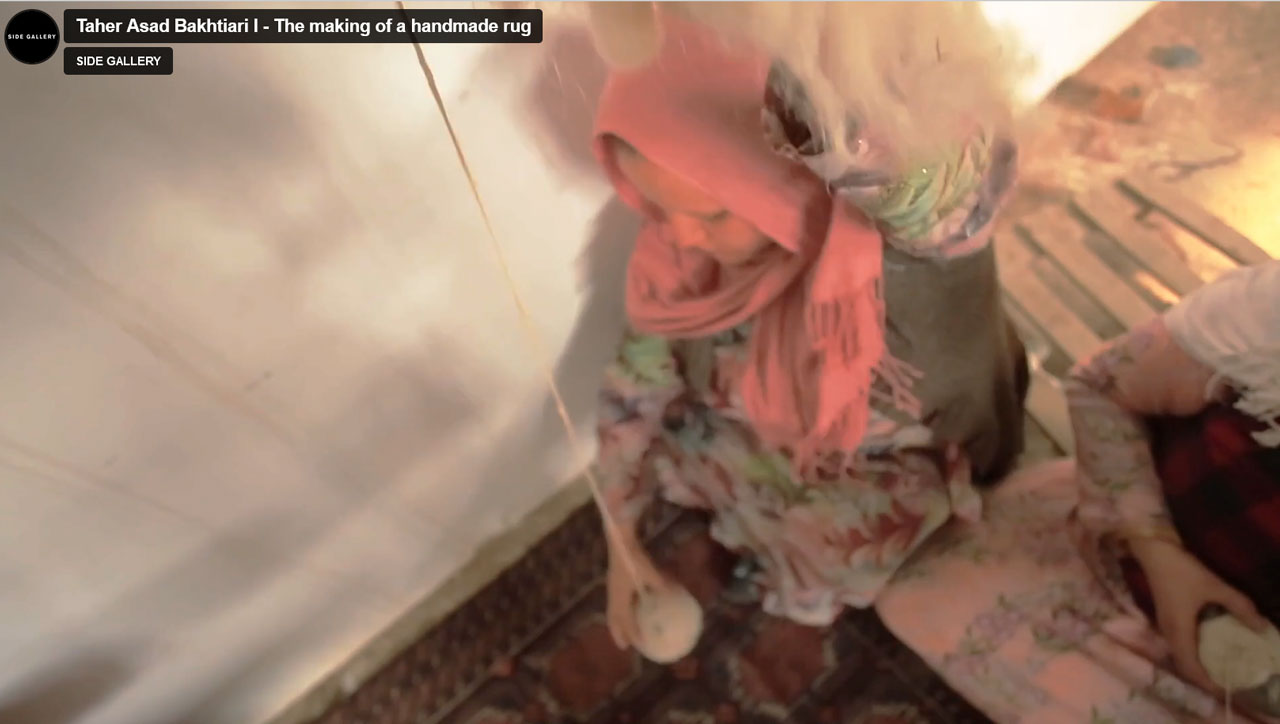VIDEO: Taher Asad Bakhtiari-The making of a handmade rug
 Taher Asad-Bakhtiari (1982- ) was born in Tehran and descends from members of Iran’s semi-nomadic Bakhtiari tribe. Inspired by his heritage, Asad-Bakhtiari launched the Tribal Weave Project, his attempt to revive and reinvent a disappearing cultural craft, working with artisans to reinvent the kilim and his ancestors’ signature high-pile rug, the Gabbeh.
Taher Asad-Bakhtiari (1982- ) was born in Tehran and descends from members of Iran’s semi-nomadic Bakhtiari tribe. Inspired by his heritage, Asad-Bakhtiari launched the Tribal Weave Project, his attempt to revive and reinvent a disappearing cultural craft, working with artisans to reinvent the kilim and his ancestors’ signature high-pile rug, the Gabbeh.
Produced exclusively for Side Gallery, this seven-square-meter rug, shown in the video was woven in Afghanistan by semi-settled nomads, using 100% natural merino wool. The rug required five months to produce, and the designer has innovatively combined several different weaving techniques: Gabbeh, kilim, and lace.
The Gabbeh (meaning raw, natural) is a thick hand-woven rug of coarse texture characterised by abstract designs with fields of colours and geometric motifs. Kilim refers to a textile with a flat and thin surface, they are created by overlapping vertical (warp) and horizontal (weft) threads, rather than by knotting. Kilim rugs use simple and bold geometric designs, with slits that highlight the effect of the shapes. Lace takes the fundamentals of the historical techniques, stripping them down to reveal the lace-like texture of the underlying warp. Asad-Bakhtiari Plays with textures and pile heights, enhancing the traditional geometric shapes of a kilim, and emphasising the design but also the uniqueness of the medium.
“My tenuous yet deep-rooted connection with the Bakhtiari tribe motivates me to support this dying craft, and I draw inspiration from their unique artistic legacy. Kilims were true raw expressions of a tribe’s outlook on beauty. With the demise of tribal life, that type of art has died. What has not is the technique, and I believe the survival of this craft goes through reinvention.”
Nomadic tribes in Afghanistan still weave carpets by hand for their own use, using patterns thousands of years old memorised and passed down from mother to daughter. They shear the sheep, collect the herbs used in dyes, and weave and colour the carpets in a process that takes months. Stimulated by this new approach, the weavers themselves have come to re-think their craft and re-engage with it. Thus often, the weaver´s own input will figure discretely in the carpet – whether in a smart approach to a weaving dilemma or the personal handling of a particular design. Inspired by that tradition, Asad-Bakhtiari launched the Tribal Weave Project, his attempt to revive and reinvent a disappearing cultural craft, working with artisans to reinvent the kilim and his ancestors’ signature high-pile rug, the Gabbeh.
© & Courtesy Side Gallery-Barcelona
